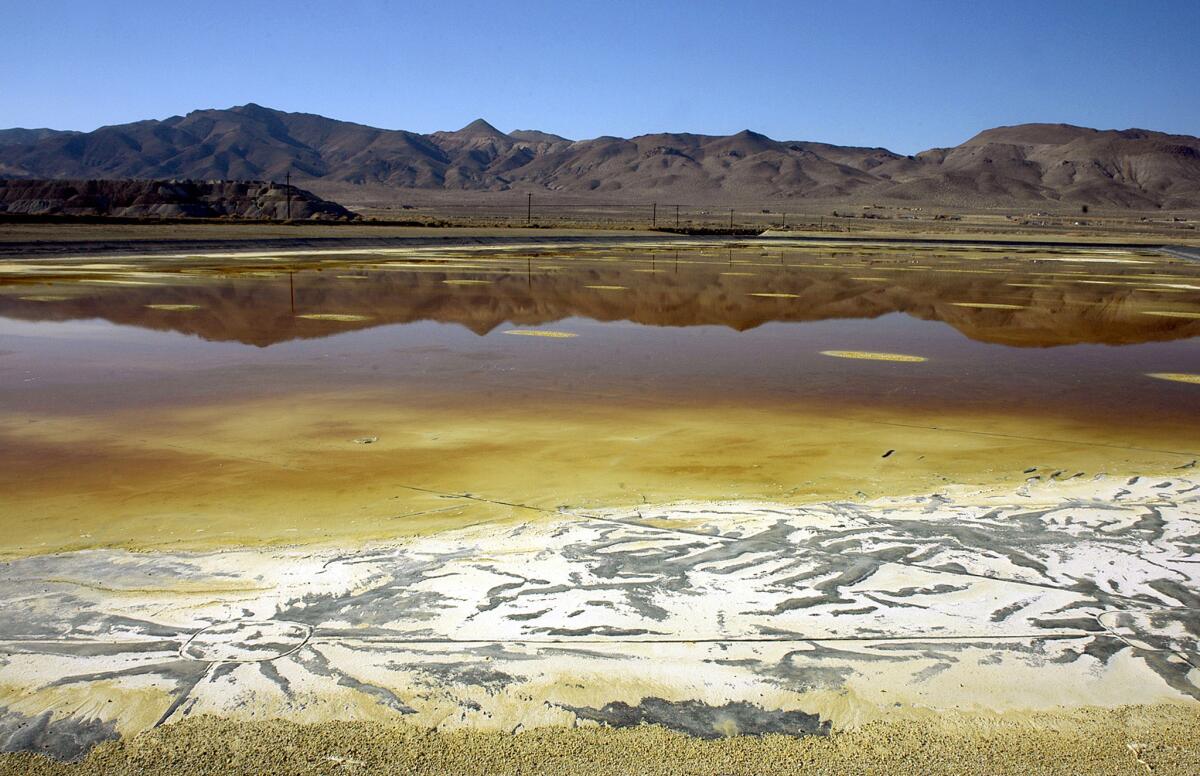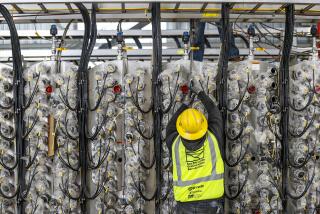EPA wants to declare abandoned Nevada copper mine a Superfund site

In this Nov. 30, 2004, file photo, an evaporation pond holds contaminated fluid and sediment at the former Anaconda copper mine near Yerington, Nev. The Environmental Protection Agency wants to add the abandoned site to its Superfund National Priority List.
- Share via
Reporting from Reno, Nev. — Fifteen years after U.S. regulators started assessing damage and health risks at an abandoned Nevada copper mine, the Environmental Protection Agency is moving to designate the contaminated land a Superfund site, a step the state could still oppose.
Rural neighbors of the World War II-era mine that has leaked toxic chemicals for decades won a $19.5-million settlement in 2013 from companies they accused of covering up the contamination to drinking water wells near Yerington, about 65 miles southeast of Reno.
The EPA sent a letter to Gov. Brian Sandoval this week announcing its intention to place the mine on the list of the nation’s most polluted sites to “mitigate exposures that are a substantial threat to the public health or welfare or the environment.”
“If we do not receive a written response from the state by Jan. 29, we will assume that Nevada is in agreement with EPA and will proceed with proposing the site for addition to the NPL,” Jared Blumenfeld, the agency’s regional administrator in San Francisco, wrote in a Dec. 22 letter obtained by the Associated Press. NPL is the acronym for the Superfund’s National Priority List.
Aides to Sandoval had no immediate comment. Nevada has opposed past EPA proposals to list the site, fearing an effect on property values and any precedent that could be set by federal intervention in the mining-friendly state, the world’s sixth-biggest producer of gold.
Join the conversation on Facebook >>
But Nevada regulators estimated earlier this year that it would cost $30.4 million to address only what the EPA considers the most immediate health and safety concerns, and the state has been unsuccessful in obtaining financial assistance from those responsible for the damage.
Under the Superfund listing, the EPA would cover 90% of the costs.
“Without an identifiable private source of funding, the only mechanism to make federal funding available is to add the site to the NPL,” Blumenfeld said.
BP’s subsidiary Atlantic Richfield has paid for other work on the site, said BP spokesman Jason Ryan.
It comes after residents filed a class-action lawsuit in 2011 accusing Atlantic Richfield Co. and parent company BP America Inc. of “intentionally and negligently” concealing the extent of uranium, arsenic and other pollutants leaking into their drinking water wells from the mine.
The mine covers 6 square miles of land owned partly by the U.S. Bureau of Land Management. Atlantic Richfield acquired the property in 1977 from Anaconda Copper, which built the mine in 1941.
Previous owners left behind 90 million gallons of acidic solution that continues to threaten the groundwater, Blumenfeld said. That’s equivalent to the amount of liquid it would take to cover about 80 football fields, 10 feet deep.
In 2008 a U.S. Labor Department review panel upheld a whistle-blower claim by ex-mine cleanup supervisor Earle Dixon, who said the BLM illegally fired him for speaking out about the risks in defiance of local politicians.
Anaconda, the former owner, produced 1.7 billion pounds of copper from 1952 to 1978 at the mine in the Mason Valley, an irrigated agricultural oasis in the otherwise largely barren high desert.
The EPA determined that the uranium was produced as a byproduct of processing the copper and that the radioactive waste was initially dumped into dirt-bottomed ponds that leaked into the groundwater.
ALSO
Immigration officials plan stepped-up deportations for new year
Man tied to cartoon contest attack accessed Islamic State list, authorities say
Chicago police were seeking Taser when officer shot Laquan McDonald, recording shows
More to Read
Sign up for Essential California
The most important California stories and recommendations in your inbox every morning.
You may occasionally receive promotional content from the Los Angeles Times.










